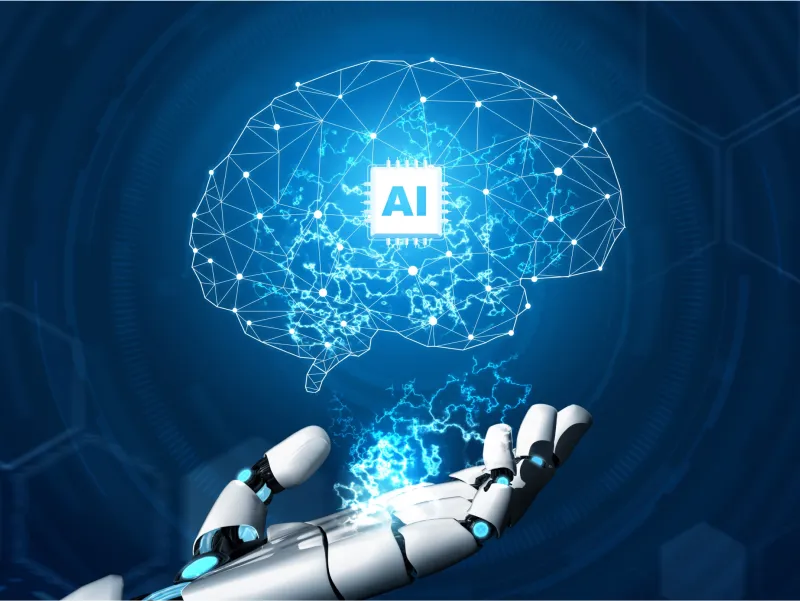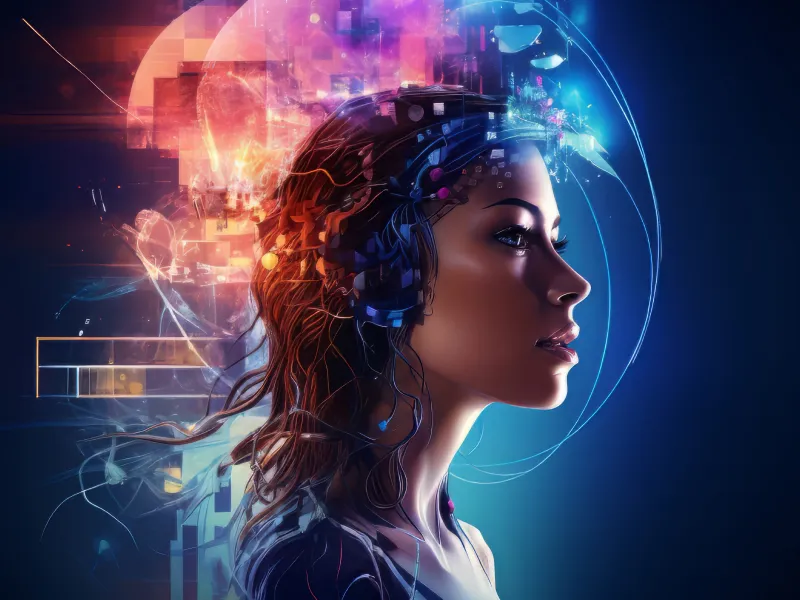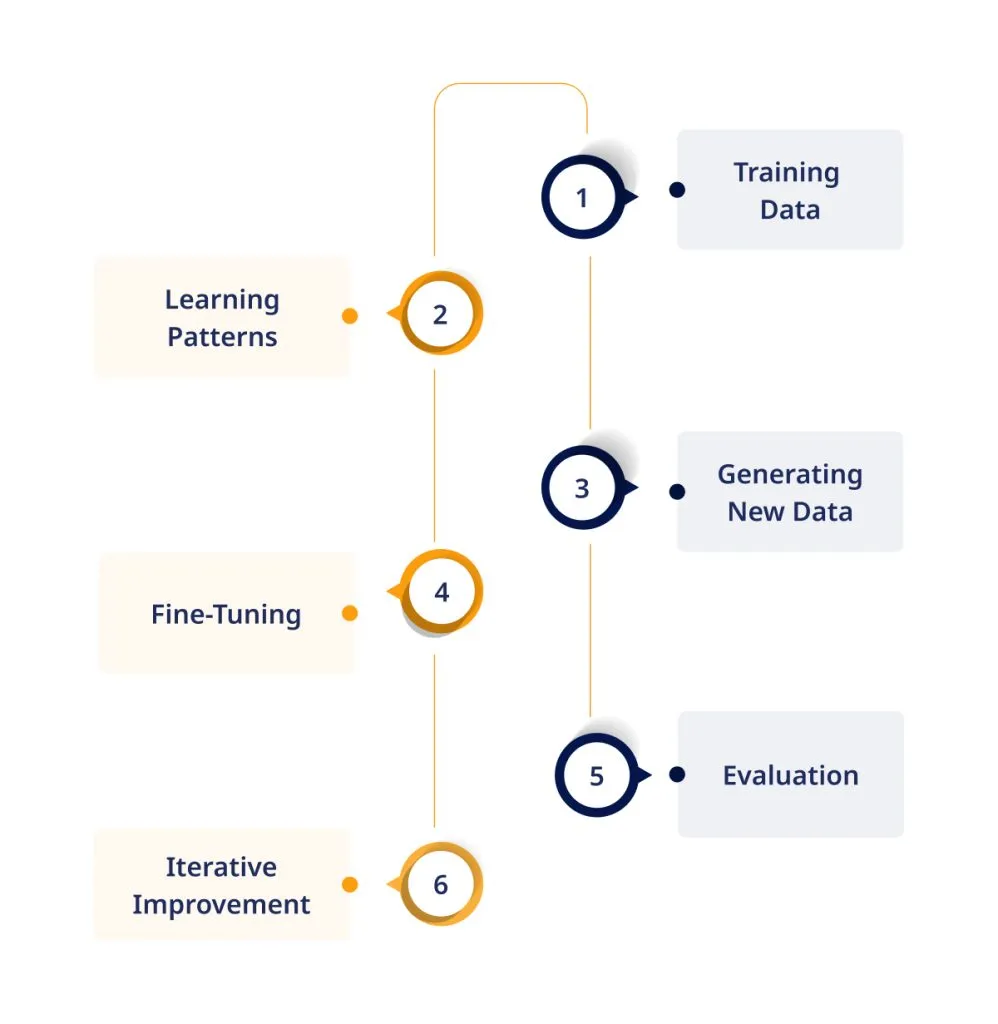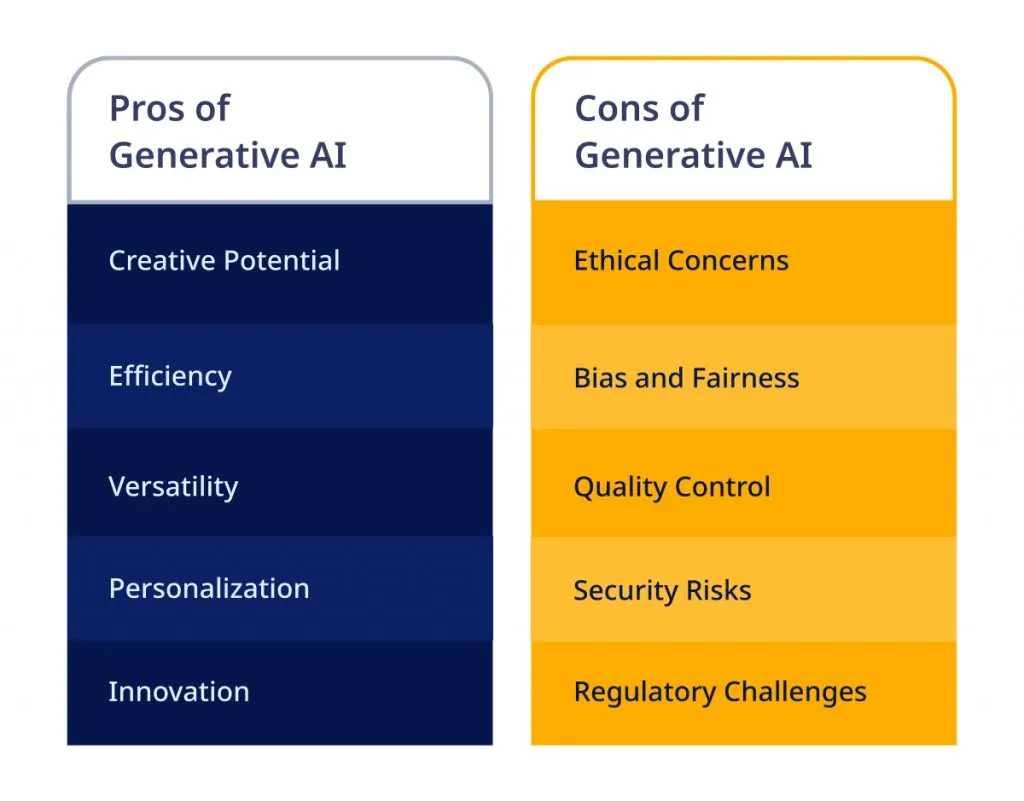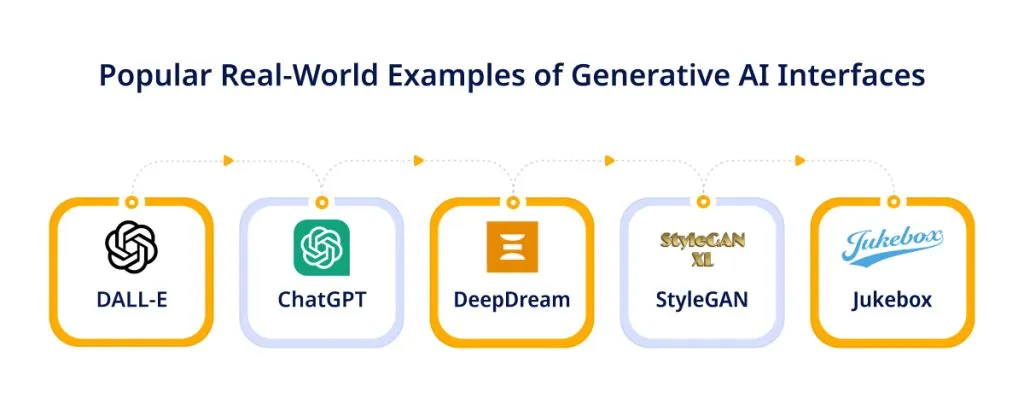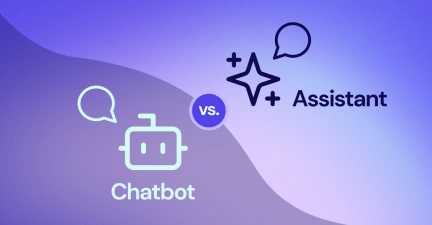In today’s fast-moving digital world, artificial intelligence keeps getting better, coming up with new ways to solve tricky problems. One of these new ways is Generative AI. But what is Generative AI, and how does it work?
Generative AI is a standout innovation in the field of AI. It lets machines create fresh and original data in different forms like text, images, sound, and video.
Generative AI models studies patterns in existing data using smart machine learning algorithms.
It then makes new things that look real, almost like how humans would create. This technology saves time by doing creative jobs automatically and creates many exciting opportunities in different areas.
However, alongside its remarkable capabilities, Generative AI prompts discussions surrounding ethical considerations and potential misuse.
As we learn more about this game-changing technology, let’s look into where it comes from, how it works, and the important advantages and disadvantages that are shaping its path in the digital world.
What is Generative AI?
Generative AI, also known as Generative Artificial Intelligence, is a leading-edge part of AI technology.
Unlike usual AI that studies and understands existing data, Generative AI can make brand-new data all by itself.
It can produce things like text, pictures, sound, or even videos that are completely new and sometimes even seem like they were made by humans.
Generative artificial intelligence services company uses complex machine learning programs that learn from huge sets of data. These programs learn to spot patterns, styles, and structures in the data they see.
Once they’ve learned enough, they can make new content all on their own by using what they’ve learned from those patterns.
Generative AI models have huge potential in many industries. It can create art and music, help make content, and even support scientific studies. The possibilities for Generative AI are wide-ranging and always growing.
However, with great power comes great responsibility. Even though Generative AI brings exciting opportunities, it also brings up serious ethical concerns.
These include things like authenticity, copyright, and the chance it might be used in the wrong way. As this technology gets better, it’s crucial to understand what it can do, what it can’t do, and how to use it in a way that’s fair and safe for everyone.
Explore new heights of creativity and productivity with ValueCoders’ expert AI solutions.
Generative AI History
Generative AI models have become more popular lately, but their beginnings go way back to the early days of AI research in the 1950s and 1960s.
The idea of generative models has been around since then, showing that this technology has been in the works for a long time.
One important early step in this area was creating models called Markov chains and Hidden Markov Models (HMMs).
These models were designed to figure out the chances of different sequences of data happening. They helped set the stage for working with and making sequences of data like text and speech.
During the 1980s and 1990s, researchers started looking into more advanced generative models. These included things like Bayesian networks and Gaussian mixture models.
These models could handle more complicated types of data, helping to improve how we understand and create data patterns. This led to progress in machine learning and figuring out probabilities.
The rise of deep learning in the late 2000s completely changed how Generative AI works.
Methods like Generative Adversarial Networks (GANs) and Variational Autoencoders (VAEs) allowed deep neural networks to be trained to make very realistic and varied data in areas like images, text, and sound.
Today, the Generative AI development company is getting better and better due to improvements in deep learning, computer power, and having big sets of data to learn from.
As scientists keep pushing the limits of what generative models can do, they’re opening up lots of exciting possibilities. This technology has the potential to change industries like entertainment, art, healthcare, and more in big ways.
Also read: Top AI Development Companies
How Does Generative AI Work?
To understand how Generative AI works, you need to know about machine learning and probabilistic modeling.
Essentially, Generative AI models use smart algorithms to create new data by recognizing patterns in existing data.
Here’s a simple explanation of how Generative AI works:
1. Training Data
Generative AI algorithms need a lot of data to learn properly. This data helps the AI figure out what patterns and features to include in its generated outputs. For instance, if it’s supposed to make pictures of cats, the training data would include many pictures of cats from different angles, types, and backgrounds.
2. Learning Patterns
While training, the AI looks at the data to find patterns, features, and connections that show up often. It learns things like shapes, colors, textures, and styles that are common in the data. This part of the process uses lots of math and special techniques to tweak the AI’s settings and ensure its ability to spot these patterns.
3. Generating New Data
After it’s been trained, the Generative AI model puts what it’s learned into action by making new data samples. For instance, if it’s learned from pictures of cats, it can make new pictures that look similar. It does this by using what it knows about the chances of different things happening and mixing them together in new ways. The generated data may exhibit variations and nuances inspired by the original dataset but can also introduce novel interpretations or variations.
Let ValueCoders help you streamline operations and unleash your creative potential.
4. Fine-Tuning
Depending on what it’s being used for, the new data might need some polishing. Fine-tuning methods can be used to make the new stuff better, more varied, or more fitting for what’s needed. This might mean changing settings, touching things up after they’re made, or adding extra rules to make sure the new data matches what’s wanted.
5. Evaluation
After making new data, it’s important to check if it’s good enough, real enough, and fits the job it’s meant for. Different things might be looked at depending on what it’s being used for, like how real it looks, how varied it is, if it makes sense, or if it’s useful. This feedback helps understand how well the Generative AI is working and can guide making it better in the future.
6. Iterative Improvement
Generative AI models are often refined and improved iteratively over time. This means they’re constantly being trained on new and improved sets of data, adjusting settings as needed, and listening to feedback on how they perform. The goal is to make them work even better, be stronger, and do more things to meet the changing demands of real-life situations.
By doing all these things, Generative AI integration services algorithms can make lots of different and imaginative things in areas like art, design, and entertainment. This technology can give useful solutions and ideas in many fields, going beyond just those mentioned.
Pros and Cons of Generative AI
Looking at the pros and cons of Generative AI models helps us understand both its possible advantages and problems.
Pros:
Some of the benefits of Generative AI include the following:
- Creative Potential: Generative AI lets computers make all sorts of new and different things like pictures, writing, sound, and video. This means there’s lots of room for new ideas and creative expression in areas like art, design, and entertainment.
- Efficiency: Generative AI makes creative jobs easier and faster, which means things get done quicker and better. It can make a lot of stuff really fast, so people can spend their time on the harder or more important parts of a project.
- Versatility: Generative AI models can be used in many different jobs and fields, like making art and music, helping with making content, designing products, and doing research. Because it can do so many things, it’s useful in lots of different areas.
- Personalization: Generative AI can change content to fit what each person likes or where it’s being used, giving users a special experience just for them. This makes people more interested and happy when they use things like recommendation systems, virtual helpers, and personalized content generation.
- Innovation: Generative AI helps come up with new ideas, looks, and thoughts that might not have been possible before. It lets people try out new things and find different ways to be creative. This pushes the limits of what’s possible and helps people find new ways to do things and discover new stuff.
Experience the benefits of AI-driven innovation and efficiency in your business processes.
Cons:
Some of the limitations of Generative AI models include the following:
- Ethical Concerns: Generative AI brings up important questions about what’s real, who owns what, and how it’s used. Sometimes, the things it makes look just like stuff people make, which can make it hard to tell the difference. This raises worries about lying, changing things on purpose, and spreading wrong information.
- Bias and Fairness: Generative AI programs might accidentally make unfair decisions or make unfair things because of the data they learn from. This could mean treating some people unfairly or making things that aren’t fair for everyone. It’s important to fix these unfairness issues and make sure everything it makes is fair and equal for everyone.
- Quality Control: Making sure the stuff Generative AI creates is good and stays the same can be hard, especially in tricky or opinion-based areas. If the things it makes vary a lot in quality, make sense, or are relevant, it might not be as helpful in real-life situations.
- Security Risks: Generative AI models can be used for bad things like making fake videos, tricking security systems, or creating misleading information to fool people. To stop these risks, we need strong protections and ways to fight back.
- Regulatory Challenges: The fast progress of Generative AI technology creates problems with rules about who owns ideas, keeping things private, and making sure people are responsible for what they do. Lawmakers and people involved need to work out complicated laws to deal with these new problems and make sure Generative AI is used the right way.
Overall, Generative AI models bring lots of excellent ideas and ways to be creative. But using it means thinking about the good things it can do, the bad things that might happen, and the important ethical questions it raises.
We need to use Generative AI carefully and thoughtfully to make the most of its potential while considering the pros and cons of AI.
Also read: How Can Generative AI Help In Building Cost Reduction Strategies?
Popular Real-World Examples of Generative AI Interfaces
Looking at real examples of Generative AI model interfaces helps us see how this technology can be useful in different jobs and areas.
These interfaces use smart computer programs to make all sorts of new and different stuff, like pictures, music, writing, and things you can interact with.
When we see how Generative AI services is used in different situations, we can understand how useful, creative, and important it is in many fields.
Now, let’s look at some specific examples to see how Generative AI is changing industries and making new things.
1. DALL-E
DALL-E, made by OpenAI, shows how Generative AI models can be used for creative tasks. People can describe things with words, and DALL-E will take pictures of them, like amazing landscapes or strange creatures. This is useful in jobs like graphic design, advertising, and making content, where it’s important to come up with new ideas fast. For example, graphic designers can use DALL-E to make pictures for ads or products, making the creative process quicker.
2. ChatGPT
ChatGPT, made with OpenAI’s GPT technology, shows how Generative AI can be utilized to understand and talk in natural language. It’s like a computer that talks to people using text. ChatGPT can help with things like answering questions, giving advice, and acting like a real person in conversations. Industries like customer service, online shopping, and education use ChatGPT to talk to customers, give suggestions, and help people learn in an interactive manner.
Also read: ChatGPT: Top 10 Use Cases In Software Development
3. DeepDream
Google’s DeepDream shows how Generative AI models can make patterns in pictures more noticeable. It was first made to help understand how computer networks see things in pictures. But now, artists and designers use it to make cool and strange pictures. They use DeepDream to make eye-catching designs, find patterns in pictures, and try out new ideas. Also, DeepDream could be useful in jobs like looking at pictures in medicine or science, where finding and understanding patterns is really important.
4. StyleGAN
NVIDIA’s StyleGAN shows how Generative AI can make and change pictures. With StyleGAN, people can make really good pictures and choose how they look, like picking facial features, haircuts, or clothes. This is useful in industries like fashion, entertainment, and virtual reality, where making lots of different and realistic pictures is important. For example, fashion designers can use StyleGAN to make virtual clothes or show customers different styles they might like.
5. Jukebox
OpenAI’s Jukebox shows how Generative AI can make and play music. Jukebox can make up its own songs in lots of different styles, with singing and instruments. This is useful in making music, entertainment, and making special stuff just for you. For instance, musicians can use Jukebox to try out new ideas, make music for videos or games, or make playlists just for you.
Let us help you generate unique and compelling content to captivate your audience.
Looking at these real examples helps us understand how Generative AI models are used in lots of different jobs to make things better, more creative, and faster.
As technology gets better, Generative AI will probably become even more important in how we use computers and express ourselves creatively.
Parting Thoughts
Generative AI is leading the way in technology, giving us amazing abilities to make new things, come up with new ideas, and do things automatically in lots of different jobs.
Using smart machine learning algorithms, Generative AI models can make all kinds of different and real things, like pictures, music, writing, and talking to people.
This is cool for being creative and getting things done faster, but it also makes us think about important stuff like being fair, doing things right, and keeping things safe.
As businesses look into what a Generative AI development company and generative AI consulting services can do, it’s really important to handle these problems in the right way while using its amazing abilities to make things better.
At ValueCoders, we promise to give you the best AI solutions made just for you. Choose ValueCoders as your reliable partner to unleash the potential of Generative AI for your business.


